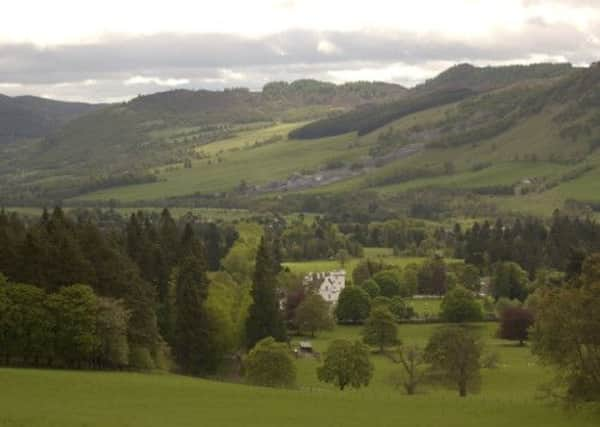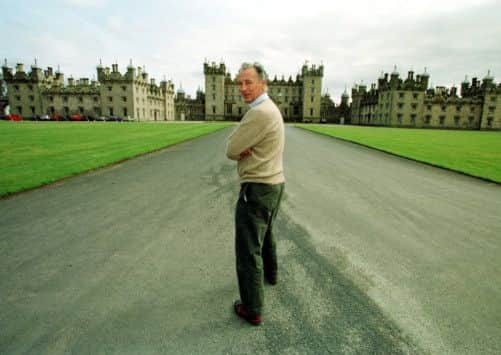Lairds warn Holyrood over new land buy-out powers


The Duke of Roxburghe and other representatives of the nobility have taken the rare step of putting their heads above their parapets to express reservations about government moves to help individuals and communities buy land that has been in their hands for generations.
They say private ownership has led to real economic benefits for local communities, providing employment and investment. Some of the submissions highlight the benefit of private ownership to endangered species, while others say absolute right-to-buy proposals have “no place in any democratic system”.
Advertisement
Hide AdAdvertisement
Hide AdThe fact that around half of Scotland is owned by just 500 people has long been a matter for fierce political debate, with land-reform campaigners arguing for a redistribution of countryside ownership.


A Land Reform Review Group (LRRG) has been set up by the Scottish Government to examine ways of increasing community ownership of the land, with an interim report suggesting earlier this year that a Land Agency could be set up to help negotiate land purchases.
In a separate move, the environment secretary, Richard Lochhead, has said that a forthcoming review of the Agricultural Holdings (Scotland) Act will look at granting an absolute right-to-buy for tenant farmers. That would give them the right to buy-out landowners, even if they are unwilling to sell.
But now a host of Scottish aristocratic families have made their views known in a series of documents published this week, defending their role as custodians of their estates.
In his submission to the Scottish Government, the Duke of Roxburghe said he was “disappointed” that the Land Reform Group appeared to concentrate on community ownership, when private ownership delivered “social, economic and environmental benefits”.
The duke owns the Roxburghe Estate, an enterprise with a £10.1 million turnover with Floors Castle, near Kelso, at its heart. The estate employs 164 people and includes the Roxburghe Hotel and a championship golf course.
Referring to an absolute right-to-buy which would increase the number of owner-occupier farms, the duke added: “Radical proposals that threaten private property rights and which impact adversely on private enterprise, investment and development or which deprive young aspiring farmers the opportunity to get a firm foothold on the farming ladder would be immensely damaging in our view and act against the interests of the communities involved.”
Roxburghe Estates emphasised that it had created employment which benefited the community, through its sporting estates, golf course, hotel and other enterprises. That theme was taken up by other lairds, who argued that breaking up estates would do little for employment prospects or investment in the countryside.
Advertisement
Hide AdAdvertisement
Hide AdIn its submission, Seafield and Strathspey Estates, which has the Earl of Seafield at its head, warned against the “fragmentation” of the land.
“Flora and fauna live in a habitat not bounded by ownership issues and the larger footprint of estate management allows government policy – including programmes for the benefit of endangered species and habitats, such as capercaillie, black grouse, native woodland, moorland etc – to be implemented more easily and cost-effectively than would be the case in fragmented ownership,” the estate’s submission said.
On the absolute right-to-buy, James Carnegy-Arbuthnot, director a family company that owns the 3,250-acre Balnamoon Estate, near Brechin, described it as a “highly vexatious proposal in the eyes of landowners”.
He added: “This amounts to the dispossession of land from one person to the advantage of another and has no place in any democratic system. Remove this threat and discussion on other land reform issues will become easier.”
Atholl Estates, which oversees 145,000 acres in Highland Perthshire, was critical of increasing community ownership as a means of redistributing land, saying: “It certainly should not be used as a tool to politically engineer property ownership away from one group of people to another as this fundamentally undermines Scotland’s credibility as a nation that respects the private sector, free markets and the protection of property rights as a cornerstone of human rights and financial security.”
Other lairds were keen to shed the pariah status that some critics have conferred on the landed classes, emphasising the benefits brought to the community through responsible land management.
A document prepared by the Douglas and Angus Estates, which are owned by the family of the former Tory prime minister Sir Alec Douglas-Home and currently under the stewardship of David, the 15th Earl of Home, remarked that the LRRG would be a “positive step, if it can help to dispel many of the popular misconceptions that landowners are villains and estates contribute little of benefit to life of rural Scotland”.
Douglas and Angus Estates argued an absolute right-to-buy would be “disastrous” for rural communities and the current ownership arrangement put the estates at the heart of community life.
Advertisement
Hide AdAdvertisement
Hide AdKinnordy Estates, Kirriemuir, owned by Lord Lyell, the former Tory minister, noted in a submission that it provided housing for the local letting market and land for the local golf course.
But other responses underlined the controversial nature of the lairds’ position. A submission by land-reform campaigner Andy Wightman said: “I want to live in a land where class distinctions are no longer legitimised by the recognition of aristocratic titles and where the principle of equality underpins access to land rights… I want to live in a country that finally puts an end to the centuries of landed power and returns the land to the people of Scotland – both men and women.”
The Scottish Government’s LRRG was established to build on the work carried out by the Labour-led Scottish Executive, which passed a Land Reform Act around ten years ago enshrining a community right- to-buy. The Review Group is looking at strengthening those measures.
A Scottish Government spokesman said: “Scottish ministers previously announced that a review of agricultural holdings legislation would be undertaken within 18 months of the Agricultural Holdings Act 2012 coming into force. The timetable for that review will be announced soon after the summer.”
“The review, once undertaken, will consider recommendations made by the Tenant Farming Forum, which is expected in the autumn.
“This will cover matters such as rent reviews; succession; compensation; and provision of fixed equipment.
“The rural affairs secretary has also confirmed an opportunity will now be provided for the industry to express views on the absolute right-to-buy as part of the review.”
What the landowners think:
‘We welcome the Land Reform Review’
Douglas and Angus estates – owned by Douglas-Home family, whose current head is David, 15th Earl of Home, pictured, “welcome the Land Reform Review as a positive step if it can helpto dispel many of the popular misconceptions that landowners are villains and estates contribute little of benefit to life of Rural Scotland. There is a huge amount of ‘popular’ criticism banded about both by the local and national Press and by government vilifying landowners in Scotland for not letting land, alienating communities, taking and not giving anything back – which we can only assume is the reason behind the current review?”
‘Land must remain with those qualified for the task’
Advertisement
Hide AdAdvertisement
Hide AdThe agent for Kinnordy Estates, Kirriemuir, owned by Lord Lyell, former Tory minister said: “In the instance of Kinnordy Estate and its locality to the town of Kirriemuir, I do not believe there is justification for the wider public community to have a stake in ownership, governance, management or use of the land… land and estate management must remain in the hands of those qualified for the task (by merit of both qualification and experience) as demonstrated on Kinnordy Estate. The Estate invests heavily in the local community – by way of investment in people, businesses and and property. It employs six full-time staff. The families of these workers, as well as those occupying estate farms and houses help support local schools and businesses, and form part of the wider community.
The estate supports local contractors and tradesmen (joiners, plumbers, electricians cleaners, fuel stations, tyre services, etc), providing benefit to the local community, on a daily basis.”
‘Responsible use should be the determining factor’
The Duke of Roxburghe said: “Responsible use of land whether in private, public or community ownership, should be the determining factor and we are disappointed that the remit of the Review Group concentrates so heavily on expansion of community ownership.
“Private membership can and does deliver, as we demonstrate in our evidence, significant social, economic and environmental benefits.”
Roxburghe Estates argues that its activities have created employment which benefits the community, through its sporting estates, golf course, hotel and other commercial enterprises.
The duke added that the proposals threatening private property rights would impact adversely on private enterprise, investment and development. He also felt they would hit young farmers, depriving them of the chance to get a firm foothold on the rural ladder. This would, he said, be immensely damaging and act against the interests of the communities involved.
‘Landowners do not harm communities’
Seafield and Strathspey Estates, the head of which is the Earl of Seafield commented: “There is a myth presented by individuals sponsoring land reform in Scotland that ‘too many acres are owned by too few individuals.’ It may be true that ‘many acres are owned by few individuals’ but there is very little evidence presented to show that this is a bad thing.
“The argument that landowners today continue to wield power to the detriment of local communities is false.”
Advertisement
Hide AdAdvertisement
Hide AdThe estate’s submission said that the fact that wildlife could live in “a habitat not bounded by ownership issues” was also a benefit.
‘So much land is unproductive’
James Carnegy-Arbuthnot, director of a family company that owns 3,250 Balnamoon Estate, near Brechin, said: “Although I have no evidence to support my opinion, I expect that one of the principal reasons why land in Scotland is owned by fewer people than anywhere else in Europe is because so much of the land is unproductive wilderness.”
He added: ”The Scottish rural economy is fragile enough without legislation being introduced for highly political reasons which will act as a major disincentive to investment in rural areas.”
Analysis: ‘Privately owned land is employed productively’
Scotland’s private landowners have a clear vision for the future of rural Scotland – to help build and sustain a healthy economy where private and community enterprises can flourish in harmony.
Our 2,500 members, across Scotland, believe this is the most productive way forward and would welcome the creation of a progressive political and legislative environment where this approach is encouraged.
Scotland’s landowners do not oppose community right to buy. Many of our members were disappointed the Land Reform Review Group appeared to focus almost exclusively on this issue rather than explore other areas of policy improvement available such as effective community planning, increased affordable housing and better local decision-making processes. We support a wide variety of community involvement and ownership models and also the principle of extending the existing community right-to-buy provisions to urban areas. Our position remains the sale of an asset should be on the basis of willing seller, willing buyer, and would not support any form of enforced asset transfer.
We were looking to the LRRG to formulate ideas which support communities in crystallising opportunities for sustainable development while at the same time reject ideas which would impact adversely on private ownership and investment to the detriment of those communities affected – such as an absolute right to buy.
We believe responsible use of land – whether in public, private or community ownership – should be the determining factor in the policy landscape.
Advertisement
Hide AdAdvertisement
Hide AdLand in the ownership of private organisations is overwhelmingly employed productively. It benefits local communities through tourism, job creation, agriculture, housing and more. Private and community ownership should not be viewed as opposite ends of a spectrum – both ensure the viability of our rural areas.
• Sarah-Jane Laing is director of policy and parliamentary affairs at Scottish Land and Estates